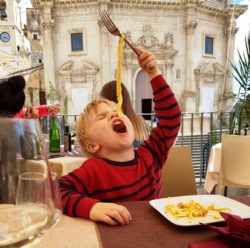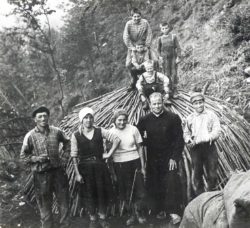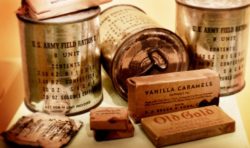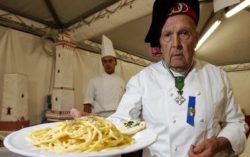Read Time: 4 Minutes Subscribe & Share
Not Your Bacon & Eggs
 About 40 years ago, a client who became a great cooking and travel buddy said she was cooking spaghetti with eggs and bacon for us. We were completely bewildered with visions of fried eggs criss-crossed with crisp strips of bacon over a mound of helpless and hopeless pasta. She, who had travelled to Italy, had eaten Spaghetti Alla Carbonara and turned this dish out in 30 minutes. We, who had never been, were amazed at this iconic dish. And as with other pasta dishes, like Spaghetti Cacio e Pepe,or Aglio, Olio e Peperoncino, it can be prepared “a mezzanotte” or at midnight, when you are hungry again and the gelato shops are closed.
About 40 years ago, a client who became a great cooking and travel buddy said she was cooking spaghetti with eggs and bacon for us. We were completely bewildered with visions of fried eggs criss-crossed with crisp strips of bacon over a mound of helpless and hopeless pasta. She, who had travelled to Italy, had eaten Spaghetti Alla Carbonara and turned this dish out in 30 minutes. We, who had never been, were amazed at this iconic dish. And as with other pasta dishes, like Spaghetti Cacio e Pepe,or Aglio, Olio e Peperoncino, it can be prepared “a mezzanotte” or at midnight, when you are hungry again and the gelato shops are closed.
My friend’s version was so satisfactory that I was determined to recreate the meal. The first time I tried to prepare this dish. I pulled out an “Italian” cookbook written by one of those writers who wrote numerous cuisine-by-country cook books: using the formula of (Fill In The Number) best dishes from (Fill In The Blank) countries. It had butter, cream, eggs, and I think bacon because in the 70s’ and 80s’ pancetta or guanciale was not available. And it was labor intensive.
Shrouded in Smoke
The roots of this dish are uncertain, and theories range from charcoal worker food to WWII American soldiers’ request that Italians make bacon and eggs. Some food historians posit that since no recipe was found recorded by Ada Boni in her book published in 1930, that it could not have been a traditional dish made by carbonai – workers who foraged wood and turned it into charcoal. Legend has it that the carbonai carried eggs, pecorino and guanciale in their bags – the pepper coating on the guanciale flavored the dish – and one food writer traced the word back to an Abruzzese term for pancetta – carbonada. British food writer Felicity Cloak wrote in The Guardian:
soldiers’ request that Italians make bacon and eggs. Some food historians posit that since no recipe was found recorded by Ada Boni in her book published in 1930, that it could not have been a traditional dish made by carbonai – workers who foraged wood and turned it into charcoal. Legend has it that the carbonai carried eggs, pecorino and guanciale in their bags – the pepper coating on the guanciale flavored the dish – and one food writer traced the word back to an Abruzzese term for pancetta – carbonada. British food writer Felicity Cloak wrote in The Guardian:
“Sophia Loren claims to have happened upon a group of these lucky fellows while filming Two Women in the mountains in the late fifties – who obligingly cooked her a slap-up carbonara lunch.”
 Food historian Francine Sagan traces the first printed recognition of SAC in La Stampa in 1950, and in Elizabeth David’s book Italian Food in 1954, which supports the theory that it evolved as a dish after World War II. Soldiers wanted something made from powdered eggs and bacon after the Allied liberation of Rome in 1944. Some evidence exists that a Bolognese chef, Renato Gualandi,(1921-2016) created the Ur Maccheroni Alla Carbonara, a main dish he prepared in the liberated seaside town of Riccione. It was to be a banquet for Allied military brass, including Harold Macmillan, and UK Generals Harold Alexander and Sir Oliver Leese. According to Gualandi, only army rations of dried foods
Food historian Francine Sagan traces the first printed recognition of SAC in La Stampa in 1950, and in Elizabeth David’s book Italian Food in 1954, which supports the theory that it evolved as a dish after World War II. Soldiers wanted something made from powdered eggs and bacon after the Allied liberation of Rome in 1944. Some evidence exists that a Bolognese chef, Renato Gualandi,(1921-2016) created the Ur Maccheroni Alla Carbonara, a main dish he prepared in the liberated seaside town of Riccione. It was to be a banquet for Allied military brass, including Harold Macmillan, and UK Generals Harold Alexander and Sir Oliver Leese. According to Gualandi, only army rations of dried foods and some meat were available, and he created a pasta dish out of the bacon, cream, processed cheese and dried egg yolk, with a generous garnish of freshly ground black pepper. In interviews later (he was the chef owner of 3G, a very successful Bolognese restaurant) Gualandi said he wanted to unite Italian cuisine with that of the Anglo-Saxon liberators. Barilla has even made a somewhat cringeworthy marketing film very loosely based on this banquet. After watching it, I felt it only fair to share this irresistible clip of Alberto Sordi in Un Americano A Roma. It offers another Italian idea of American cuisine. (You may have to turn on subtitles in settings as in some browsers they don’t appear automatically.)
and some meat were available, and he created a pasta dish out of the bacon, cream, processed cheese and dried egg yolk, with a generous garnish of freshly ground black pepper. In interviews later (he was the chef owner of 3G, a very successful Bolognese restaurant) Gualandi said he wanted to unite Italian cuisine with that of the Anglo-Saxon liberators. Barilla has even made a somewhat cringeworthy marketing film very loosely based on this banquet. After watching it, I felt it only fair to share this irresistible clip of Alberto Sordi in Un Americano A Roma. It offers another Italian idea of American cuisine. (You may have to turn on subtitles in settings as in some browsers they don’t appear automatically.)
 My favorite way of making this dish is based on the video from Giallo Zafferano. Here are some thoughts from an American cook on this most popular form of preparing pasta in Italy: Use guanciale if you can get it, as it is fattier than pancetta and that rendered fat makes for a creamier sauce…also the pepper from the guanciale adds a little extra kick. If you use pancetta, then you may want to add a bit of oil to your pan as you gently sauté it. In either case, you want to sauté over medium low heat. You do not want it crisp and brown like bacon. Which reminds me, bacon is smoked, while pancetta and guanciale are simply cured, and the resulting flavor will be different. You must take the pan off the heat (do not just turn the burner off) right before you add the egg mixture. Also don’t be afraid to add more pasta water to get your sauce creamy. I find that it varies each time I make it.
My favorite way of making this dish is based on the video from Giallo Zafferano. Here are some thoughts from an American cook on this most popular form of preparing pasta in Italy: Use guanciale if you can get it, as it is fattier than pancetta and that rendered fat makes for a creamier sauce…also the pepper from the guanciale adds a little extra kick. If you use pancetta, then you may want to add a bit of oil to your pan as you gently sauté it. In either case, you want to sauté over medium low heat. You do not want it crisp and brown like bacon. Which reminds me, bacon is smoked, while pancetta and guanciale are simply cured, and the resulting flavor will be different. You must take the pan off the heat (do not just turn the burner off) right before you add the egg mixture. Also don’t be afraid to add more pasta water to get your sauce creamy. I find that it varies each time I make it.


- 320gr (11oz) spaghetti ( I sometimes use 360gr)
- 6 egg yolks
- freshly ground pepper on hand
- 150gr (5.25oz) guanciale (pancetta can be substituted if necessary with the addition of some olive oil for frying)
- 50gr (1.75oz) pecorino romano, finely grated (fine microplane)
- Put your grated cheese in one prep bowl, your yolks in another and start your stockpot of water to boil.
- Cut the hard rind off the cured pork piece and slice and then dice pork in smallish pieces - 1cm.
- In a frypan (I use copper, aluminum or triple-layer stainless steel - the extra layer tries to make stainless a better heat conductor) over medium low heat, gently saute the pieces for about 15 minutes. Fat should be rendered and the pieces should be golden brown, not dark brown.
- While that is happening, your water should be boiling, so add salt and then the pasta.
- Whisk the yolks with most of the grated pecorino (the rest will be used to garnish the pasta at the end).
- Add a ladle of the pasta water to the yolk and cheese mixture, whisking all the time - it should be a loose paste or mayonnaise.
- When the pasta is barely cooked through, using tongs or a spider to fish it out, add it to the pan with the guanciale/pancetta, and stir it together so that the wet pasta mixes in with the rendered fat and the pork pieces.
- Remove the pan from the heat and pour the yolk/cheese mixture, stirring constantly.
- Add some more pasta water until you get the texture you want and serve immediately, garnished with some additional pepper and grated pecorino.
- I don't use carbon steel or cast iron to make this dish as I found that it browns the guanciale too quickly.

Kitchen Detail shares under the radar recipes, explores the art of cooking, the stories behind food, and the tools that bring it all together, while uncovering the social, political, and environmental truths that shape our culinary world.




Thank you for the tip about carbon steel and cast iron. I struggle with the guanciale burning or getting to crisp. I use that exact recipe. I get the guanciale at Italian store on lee highway. You’ve inspired me , I’m making this tomorrow!
Ciao Thom!
You need to paint a still life of your newly achieved spaghetti carbonara! Yes, once I switched pans, I could get the fat rendered without turning the guanciale into bacobits. I do like the idea of @domenicacooks in her comment below about adding a bit of white wine.
Nancy
Thanks for this detailed post on one of Italy’s most famous pastas. Confession: I put 2 tablespoons of cream in my carbonara, as I think it mitigates the “egginess” of the dish. Also, I sometimes (not always) deglaze the guanciale/pancetta with a splash of wine, which really boosts the flavor. Heresy, I know!